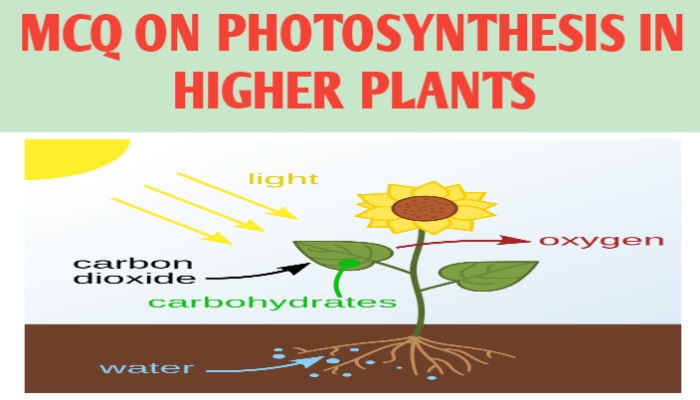MCQ ON PHOTOSYNTHESIS IN HIGHER PLANTS class 11 for NEET | PHOTOSYNTHESIS IN HIGHER PLANTS class 11 MCQ PHOTOSYNTHESIS IN HIGHER PLANTS with Answer | Check the below NCERT MCQ question for class 11 Biology chapter 13 based on the PHOTOSYNTHESIS IN HIGHER PLANTS with Answers.
MCQ on PHOTOSYNTHESIS IN HIGHER PLANTS class 11 Biology with answers were prepared based on the latest pattern.We have provided class 11 Biology MCQs questions on PHOTOSYNTHESIS IN HIGHER PLANTS with Answers to help students understand the concept very well.

MCQ ON PHOTOSYNTHESIS IN HIGHER PLANTS
MCQ PHOTOSYNTHESIS IN HIGHER PLANTS is useful for NEET / CSIR / UGC / CBSE / ICSE / AIIMS / EXAM / AFMC EXAM / STATE LEVEL MEDICAL EXAM 2022-23
Introduction:-
All animals including human beings depend on plants for their food. Green plants carry out photosynthesis a physico – chemical process by which they use light energy to drive the synthesis of organic compounds. Ultimately , all living forms on earth depend on sunlight for energy.The use of energy from sunlight by plants doing photosynthesis is basis of life on earth. The use of energy from sunlight by plants doing photosynthesis is the basis of life on earth. Photosynthesis is important due to two reasons : it is the primary source of all food on earth.It is also responsible for the release of oxygen into the atmosphere by green plants.
MCQ ON PHOTOSYNTHESIS IN HIGHER PLANTS class 11 for NEET
1. The photosynthesis is
(a) biochemical process
(b) physico-chemical process
(c) chemical process
(d) biological process
Ans (b) physico-chemical process
2. Most of the photosynthesis takes place in the
(a) blue and red regions of the spectrum
(b) green and red
(c) white and red
(d) green and red
Ans. (a) Blue and red regions of the spectrum
3. Accessory pigments are
(a) chlorophyll b , xanthophyll and carotenoids
(b) chlorophyll a , chlorophyll b and xanthophyll
(c) chlorophyll a, chlorophyll b
(d) none
Ans. (a) chlorophyll b , xanthophyll and carotenoids
4. The light reactions or the photochemical phase include
(a) light absorption
(b) water splitting
(c) oxygen release and formation of ATP and NADPH
(d) all the above
Ans.(d) all the above
ALSO READ:-
● YOU CAN WATCH BIOLOGY SIR Youtube channel
5.In photosynthesis , light reactions occur in
(a) thylakoids
(b)fret channel
(c) stroma
(d) all the above
Ans.(a) thylakoids
6. The photolysis of water takes place in
(a) Calvin cycle
(b) glycolysis
(c) light phase
(d) dark phase
Ans.(c) light phase
7. Photolysis of water is associated with
(a) PS I
(b) PS II
(c) cytochrome b
(d) cytochrome c
Ans.(b) PS II
8. The primary acceptor during CO2 fixation in C3 plants is
(a) Ribulose biphosphate
(b) Glycolate
(c) phosphoenol pyruvate
(d) triose phosphate
Ans.(a) Ribulose biphosphate
9. The first stable product of dark reaction in C3 plant is
(a) PEP
(b) RuBP
(c) PGA
(d) OAA
Ans. (c) PGA
10.The Photosynthetically active radiation is represented by the range of wavelength of
(a) 640-650 nm
(b) 600-950 nm
(c) 400- 700 nm
(d) 300 – 450 nm
Ans. (c) 400 – 700 nm
11. Agranal chloroplasts occur in certain
(a) succulents
(b) C4 plants
(c) all plants
(d) algae only
Ans.(b) C4 plants
12. The C4 plants are found in
(a) monocots only
(b) dicots only
(c) graminea only
(d) monocots as well as dicots
Ans.(d) monocots as well as dicots
13. The factor , which is not limiting in normal conditions for photosynthesis , is
(a) light
(b) water
(c) carbon dioxide
(d) chlorophyll content
Ans. (d) chlorophyll content
14. Photo phosphorylation takes place in
(a) oxisome
(b) ribosomes
(c) peroxisome
(d) chloroplasts
Ans.(d) chloroplasts
15. The thylakoids occur in
(a) mitochondria
(b) chloroplasts
(c) Golgi apparatus
(d) endoplasmic reticulum
Ans. (b) chloroplasts
16.The C4 plants are abundant in
(a) temperate region with more humid conditions
(b) temperate region with dry conditions
(c) tropical region with more humid conditions
(d) tropical region with more dry conditions
Ans.(d) tropical regions with more dry conditions
17. The chlorophyll molecules are green in colour because
(a) transmit green light
(b) transform green light
(c) reflects green light
(d) absorb green light
Ans.(a) transmit green light
18. Insectivorous plants are usually adapted to
(a) water rich soils
(b) soils deficient in sugars
(c) soil rich in trace elements
(d) soils deficient in nitrogenous compounds
And.(d) soils deficient in nitrogenous compounds
19. Where do you find cytochrome b6 and f ?
(a) chloroplasts
(b) lysosome
(c) ribosomes
(d) mitochondria
Ans. (a) chloroplasts
20. The core elements of chlorophyll is
(a) Mn
(b) Mg
(c) Zn
(d) Fe
Ans.(b) Mg







Leave a Comment